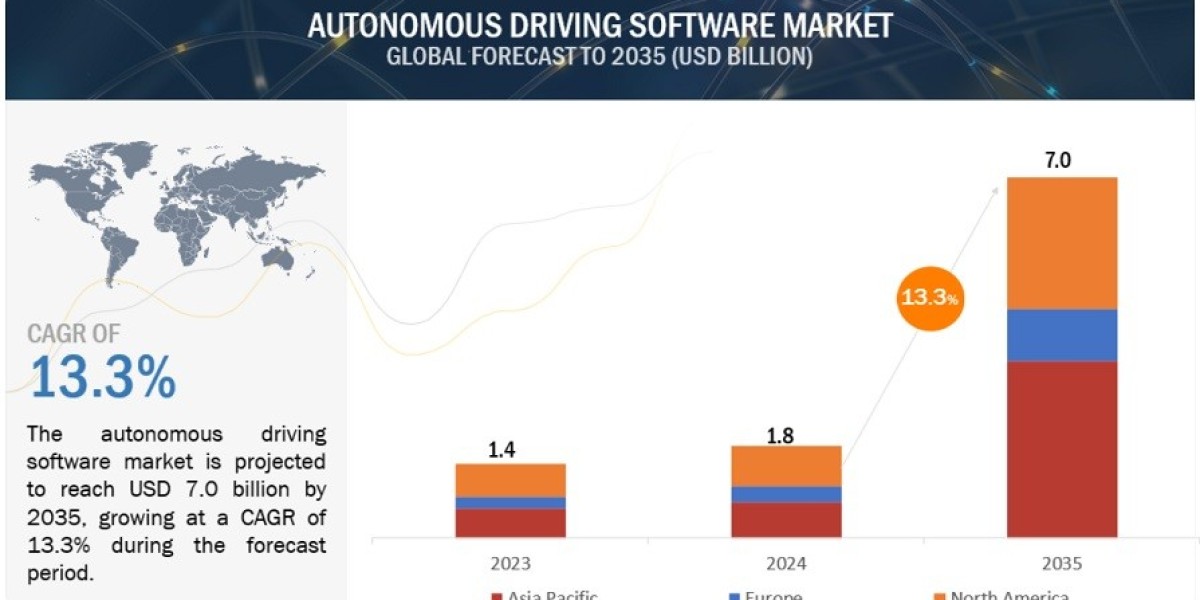The global autonomous driving software market size is projected to grow from USD 1.8 billion in 2024 to USD 7.0 billion by 2035 at a CAGR of 13.3% during the forecast period. The autonomous driving software market is fueled by regulatory backing and government initiatives to develop and deploy semi-autonomous and autonomous vehicles. Advances in ADAS technology, as well as the incorporation of 5G technology for car communication, are strengthening the market for autonomous driving software. The increased capabilities of this technology enable the complicated algorithms and data requirements of autonomous driving software, hence fueling industry demand and development.
ICE vehicle segment is expected to hold a significant share of the autonomous driving software market, by propulsion type during the forecast period. The large market presence of ICE vehicles, particularly in the luxury vehicle sector, will result in a significant penetration of autonomy in ICE vehicles in the early years. Mercedes-Benz, Volvo, BMW, General Motors, Ford, Volkswagen, and Toyota plan to launch ICE L2+ and L3 vehicles. Mercedes-Benz has been marketing its S Class L3 autonomous vehicle in Europe since 2022, and it also received approval for use in the United States. However, ICE-autonomous vehicles will find fewer applications in the long term due to the growing need for emission-friendly transportation globally.
Download PDF Brochure @ https://www.marketsandmarkets.com/pdfdownloadNew.asp?id=247907500
The commercial vehicle segment is expected to grow at a significant rate in the autonomous driving software market during the forecast period. Commercial vehicles nowadays are equipped with various automated driving technologies or ADAS features, such as blind-spot monitoring, lane-departure warning, collision-mitigation systems, adaptive cruise control, air disc brakes, electronic stability control, and video monitoring. Commercial vehicles are used in a wide range of commercial activities, including delivery, public transportation, and long-distance transportation. Growing safety awareness and technological improvements have prompted global OEMs to incorporate autonomous driving systems into commercial vehicle applications. For example, in March 2024, PlusAl teamed with the TRATON GROUP's Scania, MAN, and Navistar to develop a commercial autonomous transportation solution using Scania, MAN, and Navistar trucks outfitted with PlusAl's autonomous technology. Further, in March 2024, Volvo Autonomous Solutions collaborated with Aurora to unveil the Volvo VNL autonomous truck at the ACT Expo in Las Vegas. It contains Aurora Driver, a self-driving platform with two CPUs, powerful software, lidar, high-resolution cameras, and imaging radar. Moreover, in January 2024, Continental AG (Germany) and Aurora Innovation, Inc. (US) collaborated for the development and deployment of the first commercial version of Aurora's integrated hardware and software system, Aurora Driver.
L4 vehicle segment is expected to at a faster pace during the forecast period. An L4 system allows a vehicle to drive independently under pre-trained or predetermined parameters. It can manage driving activities including steering, stopping, and accelerating, as well as complex situations like the unexpected emergence of construction sites, barricades, or other impediments without the driver's participation. However, the driver must remain engaged in order to override the system in an emergency. L4 vehicles have not yet commercially launched because of various issues, including a lack of infrastructure and regulatory constraints. These vehicles are expected to be on the market by 2028, with numerous OEMS preparing to launch them. For instance, Volkswagen ADMT and Mobileye signed an agreement to cooperate on autonomous driving, as part of which, Mobileye will provide self-driving ID software, hardware, and digital maps for Volkswagen to develop an autonomous Level 4 service vehicle for large-scale production, targeting commercial use in Europe and the US. Similarly, in March 2024, Hyundai Motor Company (South Korea) collaborated with PlusAl Inc. (US) to launch its first Level 4 autonomous (Class 8) hydrogen fuel cell electric truck in the US. Furthermore, in January 2024, Aurora Innovation Inc. (US) launched Aurora Driver, an autonomous driving system (ADS) developed by Aurora Innovation Inc. and Continental AG for driverless semi-trucks and large vehicles.
Asia-Pacific region is expected to dominate the autonomous driving software market during the forecast period. China, South Korea, and Japan account for the Asia-Pacific region's largest autonomous driving software market share. The market growth in this region can be attributed to the high vehicle production and increased use of advanced electronics in China, South Korea, and Japan. These countries' governments have recognized the automotive industry's growth potential and taken different initiatives to encourage major OEMs to enter their domestic markets. Several European and American automobile manufacturers, such as Volkswagen (Germany), Mercedes-Benz (Germany), and General Motors (US), have shifted their production plants to developing countries. Major autonomous driving software providers, including Huawei Technologies Co., Ltd. (China), Hitachi Astemo, Ltd. (Japan), Baidu, Inc. (China), and Hyundai (South Korea), operate throughout the region. These OEMs have partnered with a number of major worldwide software and hardware developers working on self-driving cars. For example, in April 2024, Pony.ai collaborated with Toyota and its Chinese joint venture, GAC Toyota, to accelerate the commercial deployment of self-driving vehicles in China. Furthermore, the region is home to a number of tech start-ups developing autonomous vehicle technologies.
Request free Sample Report @ https://www.marketsandmarkets.com/requestsampleNew.asp?id=247907500



